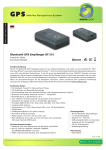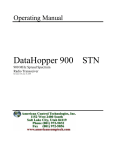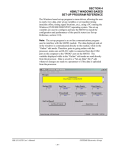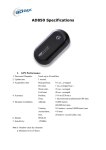Download User's Manual - Cheng Holin Technology Corp
Transcript
User’s Manual GE-218S GPS Receiver Module Version 1.00 ii GE-218S GPS Receiver Module Revision History Ver. 1.00 Date Nov. 14th, 2006 Description Initial Draft iii GE-218S GPS Receiver Module 1 2 3 4 INTRODUCTION.................................................................................................................................. 1 1.1 OVERVIEW.............................................................................................................................. 1 1.2 FEATURES ............................................................................................................................... 1 1.3 TECHNICAL SPECIFICATIONS.................................................................................................... 2 1.4 SERIAL COMMUNICATION INTERFACE ...................................................................................... 2 OPERATIONAL CHARACTERISTICS............................................................................................... 3 2.1 INITIALIZATION ....................................................................................................................... 3 2.2 NAVIGATION ........................................................................................................................... 3 HARDWARE INTERFACE................................................................................................................... 4 3.1 PCB DIMENSION AND LAYOUT DESCRIPTIONS ......................................................................... 4 3.2 20-PIN I/O INTERFACE ............................................................................................................. 4 SOFTWARE INTERFACE.................................................................................................................... 6 4.1 NMEA TRANSMITTED MESSAGES ........................................................................................... 6 4.1.1 GPGGA sentence ................................................................................................................... 7 4.1.2 GPGLL sentence .................................................................................................................... 8 4.1.3 GPGSA sentence .................................................................................................................... 9 4.1.4 GPGSV sentence .................................................................................................................... 9 4.1.5 GPRMC sentence ..................................................................................................................10 4.1.6 GPVTG sentence...................................................................................................................11 4.1.7 GPZDA sentence...................................................................................................................11 4.1.8 PSGSA sentence....................................................................................................................12 4.2 NMEA MESSAGE DATA OUTPUT SPECIFICATIONS ...................................................................12 4.2.1 GPGGA sentence ..................................................................................................................13 4.2.2 GPGLL sentence ...................................................................................................................13 4.2.3 GPGSA sentence ...................................................................................................................13 4.2.4 GPGSV sentence ...................................................................................................................14 4.2.5 GPRMC sentence ..................................................................................................................14 4.2.6 GPVTG sentence...................................................................................................................14 4.2.7 GPZDA sentence...................................................................................................................14 4.2.8 PSGSA message ....................................................................................................................15 4.3 NMEA MESSAGE OUTPUT TIMING .........................................................................................15 4.4 COMMUNICATION COMMAND .................................................................................................15 4.4.1 Command Format .................................................................................................................15 4.4.2 NC command (NMEA sentence output interval setting) ..........................................................16 iv GE-218S GPS Receiver Module 4.4.3 C L R c o m m a n d ( c l e a r s e t p a r a m e t e r s ) ............................................................................17 4.4.5 S W 4.4.4 4.4.6 4.4.7 4.4.8 4.4.9 4.4.1 0 5 C D c o m m a n d ( c o l d s t a r t ) .................................................................................................17 c o m m a n d (w a r m s t a r t ) ..............................................................................................17 S R c o m m a n d ( h o t s t a r t ) ...................................................................................................18 O I c o m m a n d ( m e s s a g e o u t p u t i n t e r v a l s e t t i n g ) ...........................................................18 C B c o m m a n d ( c h a n g e b a u d r a t e ) ....................................................................................18 PLM c o m m a n d ( l o w p o w e r m o d e s e t t i n g ) .......................................................................19 W A c o m m a n d ( W A A S / E G N O S f u n c t i o n s e t t i n g ) ...........................................................20 ENGINE BOARD EVALUATION KIT................................................................................................22 5.1 OVERVIEW.............................................................................................................................22 5.2 SERIAL COMMUNICATION INTERFACE......................................................................................23 5.3 INSTALLATION .......................................................................................................................23 5.4 LED INDICATIONS ..................................................................................................................23 v GE-218S GPS Receiver Module 1 Introduction 1.1 Overview The GE-218S engine board is a self-contained GPS receiver module. The GPS signal receiving, data acquisitioning and positioning meet the needs such as car navigation, mapping, surveying, agriculture and so on. GE-218S communicates with other electronic utilities via compatible serial communication channels and saves useful satellite data by memory backup to speed up the positioning. With low power consumption of 39mA, the GE-218S tracks satellites using up to 12-channel correlators at a time. It re-acquires satellite signals in 100 ms and updates position data every second. Advanced power saving mechanism allows the unit to operate at a fraction of the time and enter low power mode as it is idle. Intelligently saving satellite data and tracking history permits the user to have a quick position fix even though the receiver usually stays off. 1.2 Features The GE-218S provides the features that make the host easy for integration. Full implementation of SONY CXD2951 architecture. 12 parallel satellite-tracking channels for fast acquisition and reacquisition Provide superior navigation performance in urban canyon and foliage environments Full navigation accuracy provided by Standard Positioning Service (SPS). Integrated powerful CPU, base band and RF hardware in an SOC (System On Chip) design reduces the space and power consumption in state of the art. Advanced IC technology gets the total receiver cost saving. Allows the receiver to track the satellites using up to 12-channel correlators. High performance firmware drives an excellent positioning speed. Serial communication channel with pre-defined baud rate. No any initialization setup is required while start to use. Support NMEA0183 v3.01 data protocol or SONY proprietary protocol High performance firmware drives an excellent positioning speed. Support super cap to sustain internal clock. Fully shielded. Power saving support. 1 GE-218S GPS Receiver Module 1.3 Technical Specifications Features Specifications GPS receiver L1, C/A code, 12 channels Tracking sensitivity –152dBm (average) or better Acquisition sensitivity –139dBm (average) or better TTFF (Time to First Fix) Cold Start: 50s (average) / 60s (95% possibility) Warm Start: 35s (average) / 40s (95% possibility) Hot Start: 2s (minimum) / 6s (95% possibility) Positioning accuracy Standard Positioning Service (SPS), WAAS (optional) 2DRMS: approx. 5m Time accuracy Precision: 1µs or less Measurement data output Update time: 1 second NMEA output protocol: V.3.01 Baud rate: 9600bps (8-N-1) Datum: WGS-84 Type: RMC only Power consumption 47 mA (average/tracking); 77 mA (average/acquisition) (All without antenna) 1.4 Power supply 5V DC Antenna/RF connector Antenna power supply Active (typical gain 27dB, noise figure 1.5dB)/MCX +3.3V Operating temperature -40°C ~ +85°C Storage temperature -55°C ~ +100°C Serial Communication Interface 1. Serial communication channel and user selectable baud rate among 4800, 9600, 19200, and 38400 (default 4800) bps. 2. NMEA 0183 Version 3.01 ASCII output. (GGA, GLL, GSA, GSV, RMC, VTG, ZDA) 2 GE-218S GPS Receiver Module 2 Operational Characteristics 2.1 Initialization As soon as the initial self-test is complete, the GE-218S engine board begins the process of satellite acquisition and tracking automatically. After a position fix has been calculated, information about valid position, velocity and time is transmitted over the output channel. The GE-218S engine board utilizes initial data, such as last stored position, date, time and satellite orbital data, to achieve maximum acquisition performance. If the initial data is inaccurate, or the orbital data is obsolete, it may take more time to achieve a position fix process. The GE-218S engine board auto-locate feature is capable of automatically determining the position fix without intervention from the host system. 2.2 Navigation After the position fixing process is complete, the GE-218S engine board sends valid navigation information over output channels. These data include: 1. Latitude/longitude/altitude 2. Velocity 3. Date/time 4. Error estimates 5. Satellite and receiver status 3 GE-218S GPS Receiver Module 3 Hardware Interface 3.1 PCB Dimension and Layout Descriptions J1 Notes: 1. J1: The serial communication interface I/O connector is connected to GPS application system. 3.2 20-pin I/O Interface GE-218S engine board supports a 20-pin I/O connector to connect the host controller. 4 GE-218S GPS Receiver Module The pin definitions of 20-pin serial communication interface connector: Pin 1 2 3 4 5 Name NC VCC VBAT VCC RESET Function No function 5V DC power input 3.3V DC backup battery input 5V DC power input Active low, to reset the engine board 6 7 8 9 10 11 NC NC NC NC GND TXDA No function No function No function No function Ground Serial data output A (transmit data) 12 RXDA Serial data input A (receive data) 13 14 15 16 17 18 19 GND NC NC GND NC GND 1PPS 20 NC Ground No function No function Ground No function Ground Time mark output for one pulse per second No function I/O N/A Input Input Input Input N/A N/A N/A N/A Input Output Input Input N/A N/A Input N/A Input Output N/A Notes Do not connect this pin. Leave it open. Same as pin 4. Optional. To reduce system startup time. Same as pin 2. This pin provides an active-low reset input to the engine board. Activation of this pin will reset and start acquisition process. It may be left open if not utilized. To reset it, the low period of this input signal should be at least 100ms. Do not connect this pin. Leave it open. Do not connect this pin. Leave it open. Do not connect this pin. Leave it open. Do not connect this pin. Leave it open. No parity, 8-bit data, 1 stop-bit, NMEA and binary message data output. (TTL) Output High voltage: Min. 2.4V Output Low voltage: Max. 0.4V Binary message data input (TTL) Input High voltage: 2.0~3.6V Input Low voltage: -0.3~0.8V Do not connect this pin. Leave it open. Do not connect this pin. Leave it open. Do not connect this pin. Leave it open. This pin provides One-Pulse-Per-Second output from the engine board, which is synchronized to GPS time. Do not connect this pin. Leave it open. Notes: 1. Only one UART port is supported. 2. There is no GPIO support. 3. For demand of different baud rate and output sentences, please contact Youngtek. MOQ is required. 5 GE-218S GPS Receiver Module 4 Software Interface 4.1 NMEA Transmitted Messages The GPS Receiver Module interface protocol is based on the National Marine Electronics Association's NMEA-0183 interface specification, which is defined in NMEA 0183, Version 3.01. This engine board doesn’t support the Radio Technical Commission for Maritime Services (RTCM) for Differential Navstar GPS Services. The default communication parameters for NMEA output are 4800 baud, 8 data bits, 1 stop bit, and no parity. The NMEA-0183 Output Messages are shown as below: NMEA Record Descriptions GPGGA Global positioning system fixed data GPGLL Geographic position- latitude/longitude GPGSA GNSS DOP and active satellites GPGSV GNSS satellites in view GPRMC Recommended minimum specific GNSS data GPVTG Course over ground and ground speed GPZDA Time & Date It outputs messages in NMEA0183 (Ver. 3.01) format and can output 8 different types of sentence: GPGGA, GPGLL, GPGSA, GPGSV, GPRMC, GPVTG, GPZDA and PSGSA. If 9600bps or 19200bps or 38400bps baud rate is set for port setting, it outputs 7 types of sentence: GPGGA, GPGSA, GPGSV, GPRMC, GPVTG, GPZDA, and PSGSA as default. Moreover, if 4800bps baud rate is set, it outputs 4 types of sentences: GPGGA, GPGSA, GPGSV, and GPRMC as default. Single message example $GPGGA,071141,3536.6019,N,13944.8906,E,1,07,01.0,00092.2,M,039.2,M,,*46 $GPGSA,A,3,03,08,11,19,20,27,28,,,,,,02.1,01.0,01.9*06 $GPGSV,3,1,09,11,81,327,52,19,43,069,49,20,33,163,45,28,32,314,47*7E $GPGSV,3,2,09,03,18,093,42,08,29,254,43,27,21,234,44,31,,,00*41 $GPGSV,3,3,09,07,,,00,,,,,,,,,,,,*77 6 GE-218S GPS Receiver Module $GPRMC,071141,A,3536.6019,N,13944.8906,E,000.0,000.0,091204,,,A*7D $GPVTG,000.0,T,,M,000.0,N,000.0,K,A*0D $GPZDA,071142,09,12,2004,,*45 $PSGSA,4,11,03,28,20,19,27,08,,,,,,02.1,01.0,01.9,01028,07114063,5*5C Single message example(at 4800 bps) $GPGGA,112350,3536.6006,N,13944.8931,E,1,08,00.9,00098.1,M,039.2,M,,*44 $GPGSA,A,3,09,10,17,18,21,26,28,29,,,,,02.1,00.9,01.8*00 $GPGSV,3,1,11,05,02,178,00,08,03,039,00,09,52,208,46,10,34,120,43*77 $GPGSV,3,2,11,15,09,322,26,17,20,175,41,18,28,313,38,21,43,283,48*78 $GPGSV,3,3,11,26,59,023,50,28,18,063,39,29,50,044,45,,,,*46 $GPRMC,112350,A,3536.6006,N,13944.8931,E,000.0,016.2,240304,,,A*7B 4.1.1 GPGGA sentence Explanation Contents Sentence ID UTC of position*1 Latitude North/South Longitude East/West GPS Quality Indicator Example $GPGGA 012041 3537.1464 N 13943.8529 E 2 Number of satellites 07 HDOP Altitude Unit 01.2 00101.2 M Unit meters Explanation GGA header hh: Hours mm: Minutes ss: Seconds dd: ° mm.mmmm: ′*2 N: North Latitude, S: South Latitude Ddd: ° mm.mmmm: ′*2 E: East Longitude, W: West Longitude*2 0: Disabled, 1: GPS positioning, 2: D-GPS positioning Number of satellites used in positioning calculation (00 to 12) *3 *4 Meters 7 GE-218S GPS Receiver Module Geoidal separation Unit Age of DGPS data DGPS reference station ID checksum <CR><LF> 039.2 M 04 0000 meters second *5 Meters Time elapsed since D-GPS reception*6 42 End of sentence Example $GPGGA,012041,3537.1464,N,13943.8529,E,2,07,01.2,00101.2,M,039.2,M,04,0000*42 Note *1 During non-position fixes, this value is increased from the last position calculation time by one second. *2 The Longitude is always expressed as 0 degree when the Latitude is 90 degree, and is expressed as Longitude 0(180) degree East when the Longitude is 0(180) degree West. *3 The DOP value is expressed as two integer digits and one decimal digit. Values 99.9 and higher are expressed as 99.9. *4 The elevation is expressed as five integer digits and one decimal digit. Values of 99999.9 or more (–99999.9 or less) are expressed as 99999.9 (–99999.9). *5 The difference from the geoidal surface is expressed as three integer digits and one decimal digit. *6 The DGPS Age is expressed as two integer digits. 4.1.2 GPGLL sentence Explanation Contents Sentence ID Latitude North/South Longitude East/West UTC of position*2 Status Mode Indicator checksum <CR><LF> Example $GPGLL 3537.1483 N 13943.8511 E 034639 A A 41 Unit Explanation GLL header dd: ° mm.mmmm: ′ N: North Latitude, S: South Latitude ddd: ° mm.mmmm: ′*1 E: East Longitude, W: West Longitude *1 hh: Hours mm: Minutes ss: Seconds A: Data valid, V: Data invalid A: Autonomous, D: D-GPS, N: Data not valid *3 End of sentence Example $GPGLL,3537.1483,N,13943.8511,E,034639,A,A*41 Note 8 GE-218S GPS Receiver Module *1 The Longitude is always expressed as 0 degree when the Latitude is 90 degree, and is expressed as Longitude 0(180) degree East when the Longitude is 0(180) degree West. *2 During non-position fixes, this value is increased from the last position calculation time by one second. *3 Position system mode indicator 4.1.3 GPGSA sentence Explanation Contents Sentence ID Mode Positioning mode Satellite ID number Satellite ID number … PDOP HDOP VDOP checksum <CR><LF> Example $GPGSA A 3 05 06 01.6 01.0 01.3 05 Explanation GSA header M: Manual, A: Automatic 1: Fix not available, 2: 2D, 3: 3D ID number of satellite used in solution ID number of satellite used in solution Display of quantity used (12 max) * * * End of sentence Example $GPGSA,A,3,05,06,09,14,18,23,25,30,,,,,01.6,01.0,01.3*05 Note * The DOP value is expressed as two integer digits and one decimal digit. Values 99.9 and higher are expressed as 99.9. 4.1.4 GPGSV sentence Explanation Contents Sentence ID Total number of sentences Sentence number Total number of satellites in view Satellite ID number Elevation Example $GPGSV 2 1 08 Unit 05 61 degrees Azimuth 056 degrees SNR (C/N) … Satellite ID number 35 dBHz Explanation GSV header Total number of GSV sentences output (1 to 9) *1 Sequence number within total number (1 to 9) Number of satellites visible from receiver Satellite ID (01 to 32) *2 Elevation angle of satellite as seen from receiver (00 to 90) Satellite azimuth as seen from receiver (000 to 359) Received signal level C/N (00 to 99) *3 14 Write for four satellites 9 GE-218S GPS Receiver Module Elevation Azimuth SNR (C/N) checksum <CR><LF> 52 321 42 70 degrees degrees dBHz End of sentence Example $GPGSV,2,1,08,05,61,056,35,06,12,158,41,09,23,066,41,14,52,321,42*70 Note *1 For 4800 bps, the maximum output lines are 3 lines. *2 It is outputted in order of Satellite ID number. *3 “00” when not tracking 4.1.5 GPRMC sentence Explanation Contents Sentence ID UTC of position fix*1 Example $GPRMC 093931 Status Latitude North/South Longitude East/West Speed over ground Course over ground A 3536.5987 N 13944.8905 E 000.0 090.7 Date Magnetic variation East/West Mode Indicator checksum <CR><LF> 241203 Unit knots degrees degrees A Explanation RMC header hh: Hours mm: Minutes ss: Seconds A: Data valid, V: Data invalid dd: ° mm.mmmm: ′ N: North Latitude, S: South Latitude ddd: ° mm.mmmm: ′*2 E: East Longitude, W: West Longitude *2 Receiver’s speed *3 Receiver’s direction of travel Moving clockwise starting at due north dd: Day, mm: Month, yy: Year *4 E: East, W: West *4 A: Autonomous, D: D-GPS, N: Data not valid *5 76 End of sentence Example $GPRMC,093931,A,3536.5987,N,13944.8905,E,000.0,090.7,241203,,,A*76 Note *1 During non-position fixes, this value is increased from the last position calculation time by one second. *2 The Longitude is always expressed as 0 degree when the Latitude is 90 degree, and is expressed as Longitude 0(180) degree East when the Longitude is 0(180) degree West. *3 The Speed over ground is expressed as three integer digits and one decimal digit. Values 10 GE-218S GPS Receiver Module 999.9 and higher are expressed as 999.9. *4 Travel direction (Degree Magnetic) is not output. *5 Positioning system mode indicator 4.1.6 GPVTG sentence Explanation Contents Sentence ID Course over ground Example $GPVTG 275.6 Unit Explanation VTG header Receiver’s direction of travel Moving clockwise starting at due north degrees T Course over ground Speed over ground Unit Speed over ground Unit Mode Indicator checksum <CR><LF> M 000.0 N 000.0 K A 0B degrees Receiver’s direction of travel*1 knots Receiver’s speed (knots) *2 knots Receiver’s speed (km/h) *2 km/h A: Autonomous, D: D-GPS, N: Data not valid *3 km/h End of sentence Example $GPVTG,275.6,T,,M,000.0,N,000.0,K,A*0B Note *1 Travel direction (Magnetic Degrees) is not output. *2 The Speed over ground is expressed as three integer digits and one decimal digit. Values 999.9 and higher are expressed as 999.9. *3 Positioning system mode indicator 4.1.7 GPZDA sentence Explanation Contents Sentence ID UTC Day Month Year Local zone hours Local zone minutes checksum <CR><LF> Example $GPZDA 105512 12 11 2003 Unit hour minute Explanation ZDA header UTC time Day according to UTC time Month according to UTC time Year according to UTC time * * 48 End of sentence 11 GE-218S GPS Receiver Module Example $GPZDA,105512,12,11,2003,,*48 Note * Local zone hours and Local zone minutes are not output. 4.1.8 PSGSA sentence Explanation Contents Sentence ID Positioning mode Calculation satellite ID Calculation satellite ID … PDOP HDOP VDOP TCXO offset value Positioning calculation time SONY Reserve checksum <CR><LF> Example $PSGSA 4 11 23 01.5 00.9 01.2 01682 10270708 D 29 Hz Explanation PSGSA header See table Satellite ID number used in speed calculation Satellite ID number used in speed calculation Display quantity of satellite used (12 max) Speed calculation PDOP *1 Speed calculation HDOP *1 Speed calculation VDOP *1 *2 hhmmssxx hh:Hours mm: Minutes ss:seconds xx:0.01seconds Time determined in positioning calculation Reserved End of message Value 0 1 2 3 Unit Explanation Speed non-positioning 2D speed positioning Pseudo 3D speed positioning 3D speed positioning Example $PSGSA,4,11,23,27,03,08,28,20,31,,,,,01.5,00.9,01.2,01682,10270708,D*29 Note *1 The DOP value is expressed as two integer digits and one decimal digit. Values 99.9 and higher are expressed as 99.9. *2 The TCXO offset value is expressed as five integer digits. Values 99999(-99999) and higher(lower) expressed as 99999(-99999). 4.2 NMEA Message Data Output Specifications The following table describes the output data configurations in the following positioning states: 12 GE-218S GPS Receiver Module immediately after cold start, during positioning, during non-positioning and after positioning. 4.2.1 GPGGA sentence Contents UTC of position Latitude North/South Longitude East/West GPS Quality Indicator Number of satellites HDOP Altitude Geoidal separation Age of DGPS data DGPS reference station ID After cold start default (00:00:00) null N null E 0 00 null null null null null During positioning UTC Positioning results Positioning results Positioning results Positioning results 1 or 2 Positioning results Positioning results Positioning results Positioning results null/DGPS information null/DGPS information During non-positioning *1 Previous value Previous value Previous value Previous value 0 00 null*2 Previous value Previous value null/DGPS information null/DGPS information *1 During non-position fixes, this value is increased from the last position calculation time by one second. *2 Non-positioning results are based on DOP limit restrictions. So, the DOP value is displayed. 4.2.2 GPGLL sentence Contents Latitude North/South Longitude East/West UTC of position Status Mode Indicator 4.2.3 After cold start null N null E default (00:00:00) V N During positioning Positioning results Positioning results Positioning results Positioning results UTC A A or D During non-positioning Previous value Previous value Previous value Previous value UTC V N During positioning A 2 or 3 Positioning results Positioning results Positioning results Positioning results During non-positioning A 1 null null* null* null* GPGSA sentence Contents Mode Positioning mode Satellite ID number PDOP HDOP VDOP After cold start A 1 null null null null *Non-positioning results are based on DOP limit restrictions. So, the DOP value is displayed. 13 GE-218S GPS Receiver Module 4.2.4 GPGSV sentence Contents Total number of sentences Sentence number Number of satellites in view Satellite ID Elevation Azimuth SNR(C/N) 4.2.5 After cold start 1 1 00 null null null null During positioning Calculation results Calculation results Calculation results Calculation results Calculation results Calculation results Calculation results During non-positioning Calculation results Calculation results Calculation results Calculation results Calculation results Calculation results Calculation results GPRMC sentence Contents UTC of position Status Latitude North/South Longitude East/West Speed over ground Course over ground Date Magnetic East /West Mode Indicator After cold start default (00:00:00) V null N null E null null default (010303) null null N During positioning UTC A Positioning results Positioning results Positioning results Positioning results Positioning results Positioning results UTC null null A or D During non-positioning * V Previous value Previous value Previous value Previous value Previous value Previous value UTC null null N * During non-position fixes, this value is increased from the last position calculation time by one second. 4.2.6 GPVTG sentence Contents Course (True) Course (Magnetic) Speed (knot) Speed (km/h) Mode Indicator 4.2.7 After cold start null null null null N During positioning Positioning results null Positioning results Positioning results A or D During non-positioning Previous value null Previous value Previous value N GPZDA sentence Contents UTC Day Month Year Local zone hours Local zone minutes After cold start default (00:00:00) default (01) default (03) default (2003) null null During positioning UTC UTC UTC UTC null null 14 During non-positioning UTC UTC UTC UTC null null GE-218S GPS Receiver Module 4.2.8 PSGSA message Contents Positioning mode Calculation satellite ID PDOP HDOP VDOP TCXO offset value Positioning calculation time After cold start 0 null Calculation results Calculation results Calculation results 00000 null During positioning 1 or 2 or 3 Positioning results Positioning results Positioning results Positioning results Positioning results Positioning results During non-positioning 0 null null* null* null* Previous value null * During non-positioning based on DOP limit restrictions, the DOP value is displayed. 4.3 NMEA Message Output Timing NMEA messages are output within 1 s after the 1PPS pulse as shown in figure below. 4.4 Communication Command 4.4.1 Command Format The communication command format consists of “@”symbol, a command and command parameters in that order. Command input is recognized after a CR (carriage return) and a LF (line feed) are received. When an input is successfully recognized, an echo is sent back. Then if the command name and specified parameter values are entered correctly, the command is processed accordingly. However if a command or characters other than those noted in this specification is used, that operation cannot be guaranteed. Command length has a maximum limit of 127 characters (from @ symbol to line feed). If there are over 128 characters including line feed, the operation cannot be guaranteed. When the command is processed properly, a processing message (shown below) is output as follows according to the command contents. 15 GE-218S GPS Receiver Module Response to a basic command (Example) (1) @CD ← Command transmission (2) @CD ← Echo back (3) [CD] Done ← Processing message 4.4.2 NC command (NMEA sentence output interval setting) Usage method @NC dddddddd d: [0|1|2|5] Explanation This command sets the output intervals for individual NMEA sentences (GGA, GLL, GSA, GSV, RMC, VTG, ZDA) and SONY original sentence PSGSA. The command requires 8 integer values (0, 1, 2, 5). The first number indicates the GGA output interval; the second indicates the GLL output interval; the third indicates the GSA output interval; the fourth indicates the GSV output interval; the fifth indicates the RMC output interval; the sixth indicates the VTG output interval; the seventh indicates the ZDA output interval; and the eighth indicates the PSGSA output interval. There are four different interval settings: 0, 1, 2, and 5. If 0 is set, the message is not output. If any output interval arguments are not set, the current setting is used. The default setting is 10111000 for baud rate 4800bps. (GGA, GSA, GSV and RMC are output every second; GLL, VTG, ZDA and PSGSA are not.) For baud rate 9600bps and above, the default setting is 10111111. It means GGA, GSA, GSV, RMC, VTG, ZDA and PSGSA are output every second; GLL is not.) Example 1 To output GGA every time and output GSA once every two times: 16 GE-218S GPS Receiver Module @NC 10200000 Example 2 To output RMC only every time: @NC 00001000 4.4.3 CL R c o m m a n d (c le a r s e t p a r a m e te r s ) Usage method @C L R E x p l anati on This command resets the user-set parameters to the default values; clears the time, position, Almanac data, Ephemeris data, and TCXO offset value; and restarts the equipment. 4.4.4 CD c o m m a n d (c o ld s ta r t) Usage method @C D E x p l anati on This command performs a cold start reset. Cold start resetting clears the time, position, Almanac data, Ephemeris data, and TCXO offset value; and resets the software. While some user-set parameters are held, others return to the default values. 4.4.5 S W c o m m a n d (w a r m Usage method @S W E x p l anati on s ta r t) This command performs a warm start reset. Warm start resetting clears the Ephemeris data and resets the software. While some user-set parameters are held, others return to the default values. N ote If the GE-218S does not have Almanac data from four or more visible satellites, a cold start is performed instead 17 4.4.6 S R c o m m a n d (h o t s ta r t) Usage method @S R E x p l anati on GE-218S GPS Receiver Module This command performs a hot start reset. Hot start resets the software while retaining the time, initial position, Almanac data, Ephemeris data, and TCXO offset value.) While some user-set parameters are held, others return to the default values. N ote If the GE-218S does not have Ephemeris data from four or more visible satellites, then a warm start is performed instead. If the GE-218S does not have Almanac data from four or more visible satellites, then a cold start is performed. 4.4.7 O I c o m m a n d (m e s s a g e o u t p u t in te r v a l s e ttin g ) Usage method @O I i nter v al i nter v al : [0 | 1 | 2 | 5 | 1 0 ] E x p l anati on This command changes the output interval of positioning result messages. The settings are 0, 1, 2, 5, and 10 seconds. If 0 is set, message reporting isn’t outputted. To resume output, set a value other than 0. If the interval value argument is not set, the current setting is reported. The setting is held internally even if the @CD, @SW, @SS or @SR reset commands are transmitted. The default value is 1. E x amp l e Setting the output interval to every 5 seconds @OI 5 4.4.8 CB c o m m a n d ( c h a n g e b a u d r a t e ) Usage method @C B [4 8 0 0 | 9 6 0 0 | 1 9 2 0 0 | 3 8 4 0 0 ] 18 GE-218S GPS Receiver Module E x p l anati on This command changes the communication baud rate. Note 1. The baud rate is defined by hardware setting. The baud rate change using the CB command is valid only during the execution time. It returns to default baud rate as it is restarted. 2. After the baud rate is changed, the communication is stopped and thus the message output stops. To continue message output, setting communication baud rate to new setting is required. 3. The NMEA messages output of different baud rates are different. Please see section 4.1. E x amp l e Change the communication baud rate to 38400. @C B 3 8 4 0 0 4.4.9 PLM c o m m a n d ( l o w p o w e r m o d e s e ttin g ) Usage method @PL M [0 | 5 . . 1 0 ] [M D| M E ] [PD| PE ] T : [0 | 5 . . 1 0 ] i nter v al ti me of p osi ti oni ng M D: stop message i n i nter v al ti me M E : ou tp u t message i n i nter v al ti me PD: not c ontr ol E PO R T 1 2 sy nc hr oni z ed w i th sl eep i ng PE : c ontr ol E PO R T 1 2 sy nc hr oni z ed w i th sl eep i ng E x p l anati on This command sets the low power mode. If the low power mode is requested, the position update will be intermittent as specified. Interval time settings are 0, 5, 6, 7, 8, 9, 10 [sec]. If 0 is set, the low power mode is terminated and the GE-218S operates at the normal mode. If ME is set, NMEA messages are generated periodically at 1Hz. Set MD if NMEA messages are not needed between the positioning updates. If the all arguments are not set, the current setting is reported. If MD or ME, PD or PE is not set, the previous setting is held. Default setting will be selected after the @CD, @SW, @SS or @SR commands. The default values are 19 GE-218S GPS Receiver Module Interval time: 0(normal mode) Message output: ME Port control: PD Note Suggest not use ME, PE commands. E x amp l e N E M A m e s s a g e s o u tp u t in e v e r y 1 0 s e c o n d s a n d w ith o u t p o r t c o n tr o l. @PL M 1 0 M D PD 4.4.1 0 W A c o m m a n d (W Usage method @W A [O N | O F F ] [PR O N : W A A S /E G N O F F : W A A S /E G PR N : [0 | 1 2 0 . . 1 3 A A S /E G N O S fu n c t io n s e t t in g ) N ] O S f u nc ti on O N N O S f u nc ti on O F F 8 ] W A A S / E G N O S PR N nu mb er E x p l anati on This command sets the WAAS/EGNOS function. When set to ON, the GE-218S receives WAAS/EGNOS satellite signals from specified PRN number (satellite). Correction information is downloaded after the initial position measurement. The GE-218 outputs the corrected position once the information is decoded. PRN number is the WAAS/EGNOS satellite number. If 0 is set, the highest elevation angle WAAS/EGNOS satellite is automatically selected. When no argument is set, the current settings are output. When PRN is not set, the previous settings are kept. The setting is held internally even if the @CD, @SW, @SS or @SR commands are transmitted. The default values are WAAS/EGNOS function : OFF PRN : 0 (automatic WAAS/EGNOS satellite selection) N ote If WAAS/EGNOS function is set to ON from OFF or it is set to OFF from ON, a software reset 20 GE-218S GPS Receiver Module is performed. Since WAAS/EGNOS function can also be set to ON by the port setting, user have to set Port:EPORT8 to “Low” in order to use @WA command. E x amp l e W A A S /E G N O S fu n c t io n is s e t t o O N @W A O N 0 w it h a u t o m a t ic W A A S /E G N O S s a t e llit e s e le c t io n . 21 GE-218S GPS Receiver Module 5 Engine Board Evaluation Kit 5.1 Overview The Evaluation Kit is defined specially for testing the GE-218S. It connects to the GE-218S through JP1, 20-pin connector and converts the serial communication signals to the RS-232 signal level. It also connects the RS-232 signals to PC’s COM port through P1. One can run the test program on PC to get the NMEA 0183 data and issue commands from PC for binary mode operations. The Evaluation Kit outline is shown as below: Notes: 1. J2: The DC power connector, is connected to DC +5V power supply. 22 GE-218S GPS Receiver Module 2. JP1: Serial communication interface connector is defined in section 3.2. 3. P1: RS-232 port-1, is used to output the NMEA-0183 data and also used to input and output binary messages. 4. P2: RS-232 port-2. There is no such port for GE-218S. 5.2 Serial Communication interface Refer to section 3.2 for the pin definitions of 20-pin serial communication interface connector. 5.3 Installation First, it needs to connect the GE-218S engine board to the evaluation kit. The evaluation kit provides the physical link conversion for the serial communication. It can connect the P1 RS-232 port of the evaluation kit to COM port of the PC for testing. Second, it needs to setup the testing software on PC. We support a testing utility, Stella, on PC for customer test. It can also run other GPS testing tool from third party supplier. 5.4 LED indications There are two LEDs on the evaluation kit. One is for power on indicator and another is the GPS status indicator. 23













































